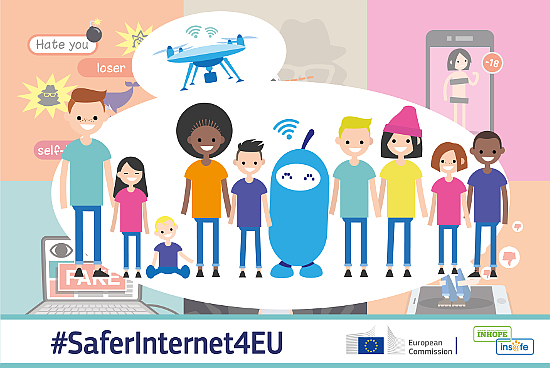Online Safety
Insafe

Welcome to the Online Safety MOOC
On this page
In a society where technology and the online world are playing an increasingly big role in people’s lives, it becomes evident that schools also need to be up to speed with the latest online trends: both in terms of the opportunities they present and the challenges they pose. Education about online safety should surely begin at home, but it is by no means the sole responsibility of parents and caretakers: teachers should also be able to provide their pupils and students with all the necessary tools to face the online world in an empowered and responsible manner. It goes without saying that industry and other stakeholders (such as government and policymakers) also have a role to play.
When it comes to online issues and trends, ‘fake news’ has unfortunately taken centre stage in 2017 – for this very reason, one of the main objectives of this online course is to promote media literacy and stress the importance of critical thinking skills, with which all children and young people should be equipped from the very start. It is only through this means that they will be able to distinguish reliable sources of information from misinformation. With multiple initiatives being undertaken at national level to educate youngsters about the dangers of fake news (for example, Le Monde journalists in France and their British counterparts from the BBC in the UK have developed resources which can be used in schools), we believe schools and teachers can play a crucial role in building young people’s resilience to fake news.
Apart from providing teachers with tools to tackle fake news in the classroom and beyond, this course intends to offer teachers essential knowledge, tips and tools to handle a wide range of issues such as online abuse, cyberbullying, sextortion, establishing positive online relationships, the impact of technology on health and well-being and, above all, hate speech and radicalisation.
Overall, this new and updated edition of the online safety MOOC will enable participants to gain a better understanding of new and old risks and challenges that young people face when they go online. With the course moderators, they will discuss strategies for supporting young people and helping them to develop safe and responsible online and offline behaviours. A wide range of resources that can be used in schools will be provided, and participants will also be asked to share their own experiences, challenges and successes.
Learning objectives
- To understand the importance of providing a safer and better internet for children and young people
- To explore the opportunities that the internet provides to access knowledge, communicate and develop skills and creativity
- To learn about online safety challenges and how to support children and young people if they encounter difficulties - including practical tips on how to handle cyberbullying, fake news, sexting and online hate speech
- To raise awareness of, and signpost to, resources for teaching online safety in schools
- To raise awareness of the Better Internet for Kids (BIK) strategy and Insafe network, as part of the network of Safer Internet Centres (SICs) in Europe, and associated resources
Prerequisites
The course is targeted at primary and secondary school teachers of any subject. ICT administrators and school counselors may also benefit from the course.
Modules
- Module 1: An Introduction to Online Safety
- Module 2: Media Literacy and Fake News
- Module 3: Cyberbullying
- Module 4: Online Relationships and Sexting
- Module 5: Hate Speech and Radicalisation
Certification
You will receive digital module badges for every completed module of the course as well as a course badge and a course certificate upon completion of the full course.
Note to teachers from Portugal: You can get your successful participation in a European Schoolnet Academy course formally recognised as a valid continuous professional development, and thereby acquire the relevant number of training hours, by sending your certificate to the Conselho Científico e Pedagógico de Formação Contínua (CCPFC) at Rua do Forno, nº 30, 1º andar - apartado 2168, 4700 - 429 Braga, Portugal. For more information, please contact the CCPFC.
Course Staff
Disclaimer and Copyright
The Better Internet for Kids (BIK) portal provides a wide range of support for teachers and other stakeholders who try to tackle online safety issues. The MOOC will therefore offer opportunities to discover some of the numerous resources available in a wide range of languages from national Safer Internet Centres (SICs).
Join us now in the Online Safety Facebook group and share your ideas about the topic on Twitter using #OnlineSafetyMOOC.
About the network of European Safer Internet Centres and the BIK portal
With funding provided by the European Commission's Connecting Europe Facility (CEF), the joint Insafe and INHOPE network of Safer Internet Centres collaborates to deliver a safer internet, promoting safe, responsible use of the internet and mobile devices to children, young people and their families, and working to identify and remove illegal content online, in line with the EC’s Better Internet for Kids Strategy. Visit the Better Internet for Kids portal for further information. For further information on CEF, visit the EC’s Digital Agenda for Europe website.
The Online Safety course is produced by Insafe (as part of the network of Safer Internet Centres in Europe) and it is owned by the European Commission, as part of the Safer Internet Day 2018 campaign.
 |
 |
 |
All content on this course unless specified otherwise is licensed under a Creative Commons Attribution-ShareAlike 4.0 International License

